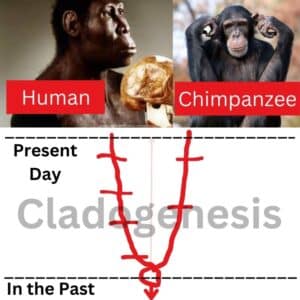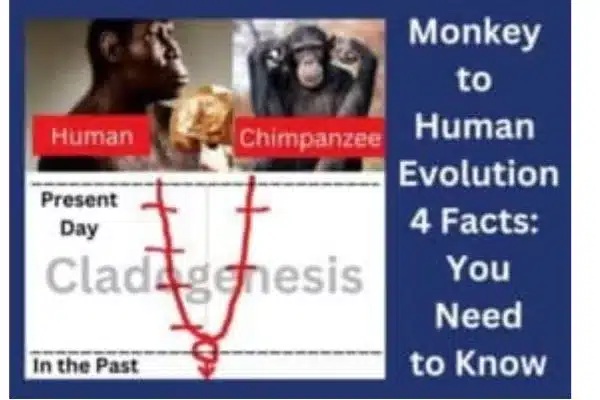Monkey Turning into Humans 4 Facts: Monkey to Human Evolution
This is not a recent question for students at all levels in this world. The question is not yet solved but scientists are very close to answering this question. Not only students but also other people also want to know this answer. The question is “Why have chimpanzees not evolved into humans in recent years?
Did human evolution occur from chimpanzees or apes? or What are the facts of Monkey to Human Evolution? To answer this question we have to be very careful because this answer is sensitive for some groups of people in the world, especially for those who don’t want to believe the theory of evolution proposed by Darwin.
We all around find chimpanzees but we do not see them as human beings anymore. If chimpanzees or monkeys are the ancestors of human beings, why are they still chimpanzees or monkeys? Why has Monkey to Human Evolution not occurred in recent years?
Why they aren`t going to be human beings again?
Some people believe that humans are not evolved from chimpanzees or monkeys. They have many questions to get the answer to that question!
Recently, in Bangladesh, the debate between the ruling party and a group of people is increasing about this issue.
Evolutionary Temeninology get to know, How Monkey Turning into Humans? Monkey to Human Evolution Dive into details:
To discuss this topic, we have to know two words, Anagenesis and Cladogenesis.
The question is; did the human being evolve in a straight line from one species to another species? The answer is NO. Humans have evolved in a different way other than a straight line of evolution. This straight line of evolution from one species to another species is called Anagenesis.
Humans have evolved in the Cladogenesis way, which means not a straight line of evolutionary changes of one species to another, rather it had a branched evolution.

What is Cladogenesis?
Cladogenesis is the branching evolution that leads to two or more lineage ( type of species) from one common ancestor in the past. Cladogenesis is an important pattern of biological diversification. Basically, Cladogenesis results in two new sister species.
The common ancestor of chimpanzee and humans were gone extinct which was developed by the Cladogenesis evolution pattern.
The fossils and the genetic evidence show that the two species of chimpanzee and humans diverged from a common ancestor 6 million years ago (approx). The common ancestor is not a single species but a set of ancestral populations that split to give rise to the two sets of populations.
In the present case, one set of populations became the modern-day humans and the other set of populations became the modern-day chimpanzee. Multiple evidence shows that Anagenesis and Cladogenesis occurred in the human lineage after the splitting of the human and chimpanzee lineage.
Questions related to Monkey Turning into Humans:
Question: Did humans evolve from chimps?
Answer: No. Just as you and your cousins share a common ancestor who lived hundreds of years ago and is long dead, all living humans share a common ancestor with all living chimps that lived millions of years ago, and that common ancestor no longer exists.
To understand this; let’s give an example, if you and your cousin share the same ancestor of your grand-grand-grandfather long ago, it does not mean that you evolved from your cousin but you and your cousin had a common ancestor of your grand-grand-grandfather. It means that your grand-grandfather is the common ancestor and you and your cousin evolved in your own way. Similarly, humans and the chimpanzee had a common ancestor who had been extinct long before ago and humans and chimpanzees are cousins of each other.
Question: How similar are Chimp’s evolution and human evolution?
Answer: It depends on what feature you are looking at.
Chimpanzees and humans are very similar in regard to their genetic characteristics. We can differentiate that the relative brain size of humans is significantly larger than that of any other primate, including chimps. This is one of the important differences between the chimps and the humans whereas intellectuality is also higher in humans than the chimps. Overall the body anatomy, they are different.
The genetic study says that humans and chimps are almost similar but humans have 23 pair of chromosome and chimps has 24 pair of chromosomes. In the nucleotide position, they share the same sequence of DNA in the chromosomes.
Question: Did Monkey to Human Evolution really Occur?
Answer: It depends on what trait or gene you are considering. For brain-related traits and genes, human DNA has generally shown more evolutionary change than chimp DNA.
Certainly, humans evolved more than chimps in all traits or sectors. The season of this evolutionary change is caused by food habits.
Question: What causes humans more evolutionary changes than chimps?
Answer: Eating meat in the food menu makes humans more brain function and larger brain size which causes more intellectuals than the chimps. The human brain size is 1500 cm3 (1.5 L) whereas the chimpanzee’s and gorillas’ brain size are 400 cm3. We know the bigger the brain size the more intellectuals are the species. The Australopithecus species also had a smaller brain size. The most ancient species of homo had also smaller brain sizes than the recent homo species.
What causes the increased brain size in humans? Is there any link for the “Monkey Turning into Humans” process?
There are two hypotheses (1) relaxed selection; this can cause the increase in brain size. For example; if all the lions are eliminated or no threat of lions to the zebras, then the brain size of the zebras will increase due to the relaxed selection in the brain.
Like humans the relaxed selection also causes the human brain to be bigger in size. The dietary changes or the food habits of eating meat cause the human brain to enlarge. The nutrient in the meat causes more protein to be stocked in the brain tissue and causes the brain larger in size.
All the members of the superfamily Hominidae, all the apes living today and all the tailless primates that have lived in the past grouped together.
Among the hominoids, humans and our recent fossil ancestors are the most flat-faced and large brain and small-toothed. Modern chimps are much more like fossil apes, gorillas, orangutans, and gibbons than humans. A scientific hypothesis shows that modern chimps are much more similar to their ancient common ancestor humans. Hence it is concluded that modern chimps and apes are not the ancestors of modern humans.
Humans: Not Descended from Monkeys
A common misconception about human evolution is the idea that we descended directly from monkeys. This is inaccurate. Humans and modern apes, such as chimpanzees, gorillas, and orangutans, share a common ancestor that lived approximately 7 million years ago.
Charles Darwin’s theory of natural selection provides the framework for understanding how species, including humans, evolved over time. This process involves the survival and reproduction of individuals best adapted to their environment, leading to gradual changes in a population over generations.
The fossil record offers compelling evidence for human evolution. Discoveries like Australopithecus afarensis, famously known as “Lucy,” have provided crucial insights into our ancestral lineage. These early hominins exhibited a combination of ape-like and human-like features, walking upright on two legs while retaining some arboreal adaptations.
It’s important to emphasize that human evolution was a complex process involving numerous species over millions of years. The path to Homo sapiens was not linear, with various branches and dead ends. While we share a common ancestor with modern apes, humans have undergone significant adaptations, including larger brains, tool use, and complex social structures.
Understanding human evolution helps us appreciate our place in the natural world and the interconnectedness of all living things. It also challenges misconceptions and fosters a deeper understanding of the scientific process.
Ref: For more details of this article of Monkey to Human Evolution Facts Please read this research article http://www.jstor.org/page/info/about/policies/terms.jsp
